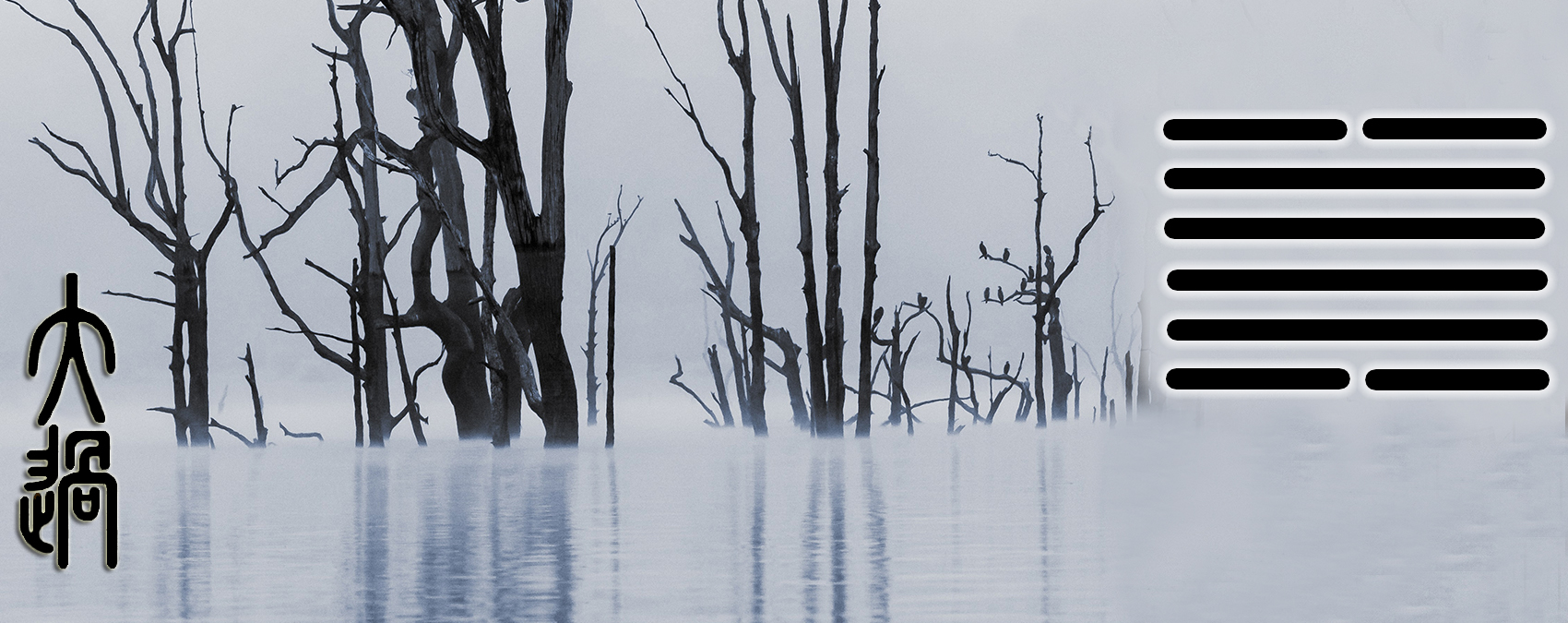Lake above – Wind/Wood below
The Chinese name of this hexagram is Da Guo. Da means great and guo translates to excess, critical, to go beyond, exceed. Other titles include Critical Mass, Greatness in Excess, Preponderance of the Great. The situation described here illustrates something which has gone past or beyond normal sustainable standards – it is over-burdened and getting toward a breaking point. This is not necessarily an immediate disaster, but a timely message indicating the need for action; information that something has entered the time of transition before change.
Breaking down the symbolism of the 3-line trigrams helps with understanding the ancient teachings:

When trigram Wind is below (the bottom 3 lines in image below right), it references the inner realm of the person or situation. Trigram Wind is the sound/voice/messenger of Earth which carries a detailed blueprint for what is coming into form. Wind is always in motion, gentle but relentless.
Trigram Lake is on top of trigram Wind (the top 3 lines in image below right). Trigram Wind (the inner trigram) is also referred to as Wood (the roots of trees can penetrate similar to winds’ penetrating ability). The hexagram image shows trees (wood) being submerged within the water of Lake. Lake is the externalized condition, one which has exceeded or overpowered the ability to continue in its current state, triggering the need for change.
The ancient ideograph is on the upper left portion of the image below. The top image shows a person standing which was seen as an image of greatness. The image below that is divided. One portion shows 3 strokes at the top for 3 steps forward and under that is an ancient sign meaning to stop or halt. The right portion shows a house with a small square inside a house showing a mouth (ancient Chinese counted people by how many mouths there were to feed). On top of the house is something that places a great excess of strain on the roof of the house.

In summary: The image formed by the actual 6 lines of this hexagram shows 4 solid/yang lines inside being held up or contained by 2 broken/yin lines (the top and bottom lines). Yin does not have the strength to contain yang and so this is a visual representation of something which has become too heavy for the “ridgepoles” to continue to support. Great Exceeding can be a natural part of the cycles of life or as a result of carelessness or inattention and may apply to myriad situations. The main component is the tension resulting from the need for a conclusion; change is imminent whether one prepares for it or not. It should be noted that making the change is considered auspicious, when change is needed, Wind carries and delivers the divine instructions for the new. Lake, as the outer reality, symbolizes opening up to others, society and having interchange. In some cases, other people’s input (represented by Lake) may overpower individuality, leaving the person to stand alone to implement the internal blueprint carried by the wind.
Following are a few ideas for interpretations of each line:
Line 1 – The use of white rushes as a mat to be placed under something on the ground is an illustration modelling the quality of care one is meant to take at the beginning of an undertaking. White rushes are apparently not easy to obtain and so may be likened to a foundation being laid with special, careful attention. Especially during times of Great Exceeding, this is said to prevent irreversible consequences at a later time.
Line 2 – A sense of renewal is granted to something which seemed to have been dying off or withering away. The image may be seen through an old willow tree in the marsh growing new shoots. There is the understanding that this remains a difficult time and one is not always able to overcome all the difficulties, but taking care and monitoring actions to align with the reality of the situation meets with some success.
Line 3 – Indicative of times when the ridgepole is bending under a weight that is overwhelming it, the ancient diviners understood that there was little to be done for the person who has become headstrong or self-willed. Sometimes the Great Exceeding is an external reality and sometimes it is as a result of self-defeating thought patterns. Guidance indicates it is best to step back and stop struggling.
Line 4 – Although it may seem on the surface that everything is moving along fine, it is important to take a good deep look, possibly going back to the original source. It may be something needs to be fixed or adjusted, even if it is difficult, it is better to do it (whether it is an exterior problem or an interior attitude). What may be inferred from this instruction is the importance of holding to higher principles despite temptations (such as ulterior motives).
Line 5 – In some situations nothing in particular is in actuality accomplished, even though this may be a period where it seems something is happening (a rejuvenated situation, an old unstable relationship, etc.). In the end it may be a no praise, no blame time as life is unfolding and the best guidance seems to be to commit to joy in the present moment.
Line 6 – If you have launched a large enterprise, it is important to understand that there is no way to avoid danger. This can happen regardless of whether one was warned and kept going or there was no inkling of difficulty ahead. If trouble comes, accept it as the consequence, especially if the undertaking is one of enduring worth. Some friction or trouble in life is essential for survival, thus lessons taken from such events may prove valuable.
